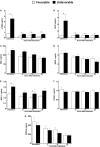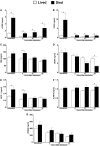Blood Biomarkers in Moderate-To-Severe Traumatic Brain Injury: Potential Utility of a Multi-Marker Approach in Characterizing Outcome
- PMID: 26074866
- PMCID: PMC4443732
- DOI: 10.3389/fneur.2015.00110
Blood Biomarkers in Moderate-To-Severe Traumatic Brain Injury: Potential Utility of a Multi-Marker Approach in Characterizing Outcome
Abstract
Background: Blood biomarkers are valuable tools for elucidating complex cellular and molecular mechanisms underlying traumatic brain injury (TBI). Profiling distinct classes of biomarkers could aid in the identification and characterization of initial injury and secondary pathological processes. This study characterized the prognostic performance of a recently developed multi-marker panel of circulating biomarkers that reflect specific pathogenic mechanisms including neuroinflammation, oxidative damage, and neuroregeneration, in moderate-to-severe TBI patients.
Materials and methods: Peripheral blood was drawn from 85 isolated TBI patients (n = 60 severe, n = 25 moderate) at hospital admission, 6-, 12-, and 24-h post-injury. Mortality and neurological outcome were assessed using the extended Glasgow Outcome Scale. A multiplex platform was designed on MULTI-SPOT(®) plates to simultaneously analyze human plasma levels of s100 calcium binding protein beta (s100B), glial fibrillary acidic protein (GFAP), neuron specific enolase (NSE), brain-derived neurotrophic factor (BDNF), monocyte chemoattractant protein (MCP)-1, intercellular adhesion molecule (ICAM)-5, and peroxiredoxin (PRDX)-6. Multivariable logistic regression and area under the receiver-operating characteristic curve (AUC) were used to evaluate both individual and combined predictive abilities of these markers for 6-month neurological outcome and mortality after TBI.
Results: Unfavorable neurological outcome was associated with elevations in s100B, GFAP, and MCP-1. Mortality was related to differences in six of the seven markers analyzed. Combined admission concentrations of s100B, GFAP, and MCP-1 were able to discriminate favorable versus unfavorable outcome (AUC = 0.83), and survival versus death (AUC = 0.87), although not significantly better than s100B alone (AUC = 0.82 and 0.86, respectively).
Conclusion: The multi-marker panel of TBI-related biomarkers performed well in discriminating unfavorable and favorable outcomes in the acute period after moderate-to-severe TBI. However, the combination of these biomarkers did not outperform s100B alone.
Keywords: BDNF; GFAP; ICAM-5; MCP-1; NSE; PRDX-6; s100B.
Figures




References
-
- Wang KKW, Moghieb A, Yang Z, Zhang Z. Systems biomarkers as acute diagnostics and chronic monitoring tools for traumatic brain injury. In: Proc. SPIE 8723, Sensing Technologies for Global Health, Military Medicine, and Environmental Monitoring III, Vol. 87230O (2013).10.1117/12.2020030 - DOI
LinkOut - more resources
Full Text Sources
Other Literature Sources
Medical
Miscellaneous

